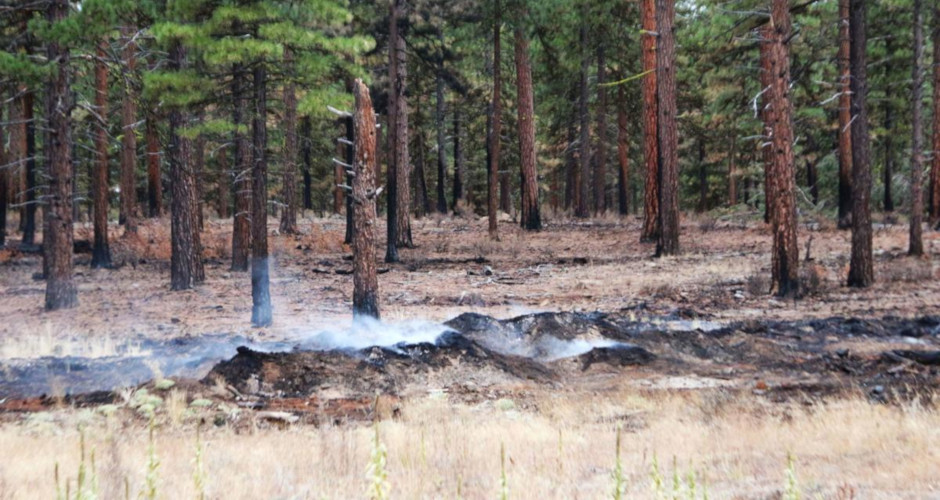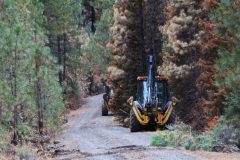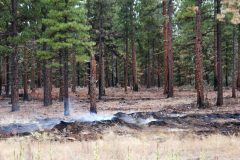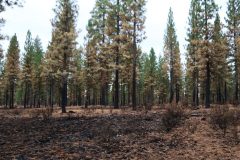Stone Fire sets standard for treatment and resiliency
— Published with Permission of HeraldandNews.com —
By any measurement 2018 was a very difficult fire season for the Western United States. People died, entire communities were tragically lost, millions of acres burned, and billions of dollars were spent in fire suppression activities.
The Stone Fire, which sparked near Alturas, Calif., in August, was just one of many that would threaten communities in the region throughout the year, but the actions to protect and treat forestland years before the first spark started, provided key lessons in tangible fire suppression going forward through proper forest management.
Treated vs. untreated
It doesn’t take long to notice the stark difference in treated and untreated areas in the wake of the lightning-caused fire, which burned over 39,000 acres after being first detected near Yellowjacket Springs Aug. 15 on the Modoc National Forest. Months after fire suppression efforts ceased, the signs are still evident of a major fire across a scarred landscape.
On one side of a muddy forest road, the land is charred grayish-black, with few if any signs of life. Most of the trees still standing were killed in the fire, with little to no signs of anything green on the ground or above. On the other side of the road, new growth appears vibrant, and healthy trees stand green and lush.
Surprisingly, the forest road in question was not the fire line held in containment efforts, both sides burned over the course of the Stone Fire. The dead side of the road was left to grow naturally. The healthy side had experienced a timber sale, tree-thinning, and prescribed burn efforts several years before the Stone Fire occurred.
Survival rate
“Because the area was previously burned, the trees are in great shape, we have greater than 90 percent retention of trees,” said Mark DePerro, fuels officer for the fire suppression efforts on the Stone Fire last August. “As the fire approached our back-fires met it, and 90 percent of the trees’ over-story survived because we had burned the area previously. Resiliency is the key word – we lost most of the trees in the area where no treatment was done, but as it entered areas where a great deal of treatments were done, the trees were retained.”
According to DePerro, on the dead side, the fire climbed the trees and consumed the over-story, burning hot at high-intensity. When it crossed the road into treated areas it remained hot for 50-100 yards inland, but through proper spacing of trees and disjointed canopy the fire dropped to ground level, switching from a high-intensity crowning canopy fire to an under-story lower-intensity burn.
The areas DePerro described were along the northwestern area of the Stone Fire, where timber sales had occurred a decade prior and prescribed burns had been conducted. In these designated areas of the Modoc National Forest, according to DePerro, harvests and burns are done on a 12-15 year interval to mimic a natural historic fire cycle.
Forest conditions
“This is really a success story for us, in areas where we did a fuel treatment it became a safe area to operate from and do backfires, and we held the fire along roads because of fuel treatments,” added DePerro. “The parts that survived were mechanically harvested about 10 years ago, and then we came in and burned in October of 2015. Fire just doesn’t want to climb trees in conditions where there is proper spacing.”
The Stone Fire, like many that occurred in 2018, caused complications; embers jumping the established lines created new spot fires, metaphorically moving the goal posts each day. It encroached on the community of Canby, resulting in some evacuations, but no homes or lives were lost in the fire, only several outlying buildings such as barns and corrals. Fire lines were drawn along county roads, waterways and connecting to pre-treated thinning projects, and re-drawn as wind shifts complicated each day’s fire suppression efforts.
“Two timber sales had recently been cut, the Turner and Craig timber sales, at the time of the fire,” said Amanda McAdams, Modoc National Forest supervisor. “Fire intensity dropped in those areas because of the treatments. We were able to utilize that work over the past few years to increase our probability of success. Without a ton of people available, we can’t go after every single fire, but pre-treatments give us a better chance of success.”
Treatment perceptions
McAdams acknowledges that there are different perceptions of what is proper treatment, but believes that the Modoc Valley has been proactive in protecting its 1.7 million acres of forest and rangelands. With resources and finances a concern each fire season, McAdams sees lessons learned from the Stone Fire in finding the highest probability of protecting priorities.
“We really have to talk about probability, if we go in direct every time and devote every resources, then we’re losing the capacity to catch the next line,” said McAdams. “Along parts of this fire we tried several times before we were successful in establishing fire lines. We shouldn’t put people into places where we’re not sure we can hold and it won’t be successful, it is wasted effort. We need to have hard conversations about not wanting to have anybody hurt or lose homes or someone’s livelihood when threatened, but there’s no point in doing it if we’re not going to be successful – I have evolved in learning how to do that better.”
Satellite imagery after the fire shows how the area burned. Consistently, patches of green indicating light burning matched areas that were pre-treated, while yellow indicating moderate burning with some tree loss, to red showing high-intensity burns with major loss of trees were confined mainly to non-treated areas. Those sites are now considered salvage to prevent the next fire.
“Perception varies of what is the right treatment,” explained McAdams. “If we cut everything then we’re not building a diverse landscape for wildlife and watersheds, but at 1.7 million acres we aren’t cutting even close to that in a 10- to 20-year span. People are sometimes concerned at the level at which we cut when we do a timber sale, but we are focused on doing treatments that provide for all resources and is resilient for everything, not just one species, and maintains watersheds.”
McAdams noted that funds collected from timber sales are often reinvested toward forest treatments, be it watershed repairs, tree thinning, or prescribed burns.
“We are never going to stop all fire on these landscapes,” added McAdams. “What we can do is moderate the severity of those fires through good forest management. We are striving to balance our priorities, but half of our workforce is in fire, which should tell you something. It can be hard sometimes to prioritize, but we’re working hard to work with our stakeholders for the greatest good for the greatest number.”






